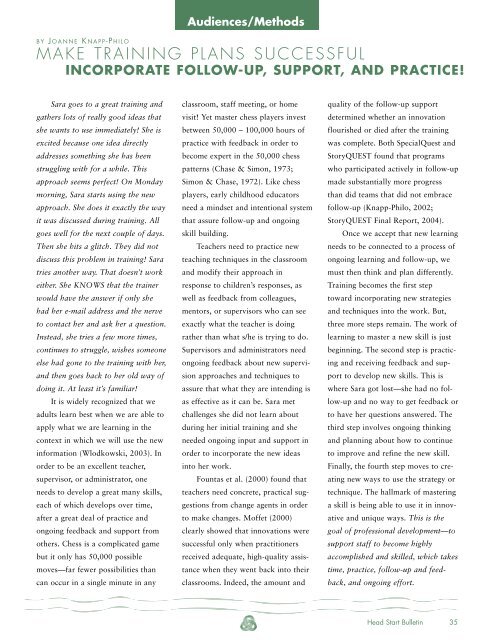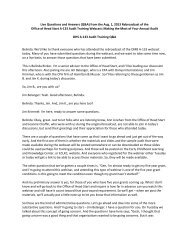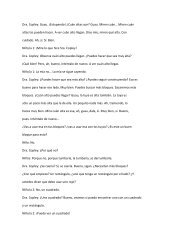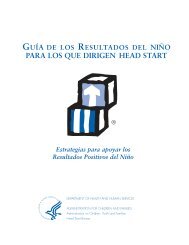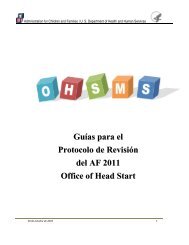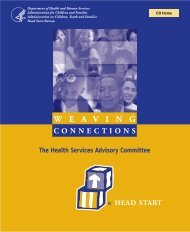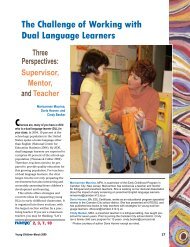Professional Development - Head Start - U.S. Department of Health ...
Professional Development - Head Start - U.S. Department of Health ...
Professional Development - Head Start - U.S. Department of Health ...
Create successful ePaper yourself
Turn your PDF publications into a flip-book with our unique Google optimized e-Paper software.
Sara goes to a great training and<br />
gathers lots <strong>of</strong> really good ideas that<br />
she wants to use immediately! She is<br />
excited because one idea directly<br />
addresses something she has been<br />
struggling with for a while. This<br />
approach seems perfect! On Monday<br />
morning, Sara starts using the new<br />
approach. She does it exactly the way<br />
it was discussed during training. All<br />
goes well for the next couple <strong>of</strong> days.<br />
Then she hits a glitch. They did not<br />
discuss this problem in training! Sara<br />
tries another way. That doesn’t work<br />
either. She KNOWS that the trainer<br />
would have the answer if only she<br />
had her e-mail address and the nerve<br />
to contact her and ask her a question.<br />
Instead, she tries a few more times,<br />
continues to struggle, wishes someone<br />
else had gone to the training with her,<br />
and then goes back to her old way <strong>of</strong><br />
doing it. At least it’s familiar!<br />
It is widely recognized that we<br />
adults learn best when we are able to<br />
apply what we are learning in the<br />
context in which we will use the new<br />
information (Wlodkowski, 2003). In<br />
order to be an excellent teacher,<br />
supervisor, or administrator, one<br />
needs to develop a great many skills,<br />
each <strong>of</strong> which develops over time,<br />
after a great deal <strong>of</strong> practice and<br />
ongoing feedback and support from<br />
others. Chess is a complicated game<br />
but it only has 50,000 possible<br />
moves—far fewer possibilities than<br />
can occur in a single minute in any<br />
Audiences/Methods<br />
BY J OANNE K NAPP-PHILO<br />
MAKE TRAINING PLANS SUCCESSFUL<br />
INCORPORATE FOLLOW-UP, SUPPORT, AND PRACTICE!<br />
classroom, staff meeting, or home<br />
visit! Yet master chess players invest<br />
between 50,000 – 100,000 hours <strong>of</strong><br />
practice with feedback in order to<br />
become expert in the 50,000 chess<br />
patterns (Chase & Simon, 1973;<br />
Simon & Chase, 1972). Like chess<br />
players, early childhood educators<br />
need a mindset and intentional system<br />
that assure follow-up and ongoing<br />
skill building.<br />
Teachers need to practice new<br />
teaching techniques in the classroom<br />
and modify their approach in<br />
response to children’s responses, as<br />
well as feedback from colleagues,<br />
mentors, or supervisors who can see<br />
exactly what the teacher is doing<br />
rather than what s/he is trying to do.<br />
Supervisors and administrators need<br />
ongoing feedback about new supervision<br />
approaches and techniques to<br />
assure that what they are intending is<br />
as effective as it can be. Sara met<br />
challenges she did not learn about<br />
during her initial training and she<br />
needed ongoing input and support in<br />
order to incorporate the new ideas<br />
into her work.<br />
Fountas et al. (2000) found that<br />
teachers need concrete, practical suggestions<br />
from change agents in order<br />
to make changes. M<strong>of</strong>fet (2000)<br />
clearly showed that innovations were<br />
successful only when practitioners<br />
received adequate, high-quality assistance<br />
when they went back into their<br />
classrooms. Indeed, the amount and<br />
quality <strong>of</strong> the follow-up support<br />
determined whether an innovation<br />
flourished or died after the training<br />
was complete. Both SpecialQuest and<br />
StoryQUEST found that programs<br />
who participated actively in follow-up<br />
made substantially more progress<br />
than did teams that did not embrace<br />
follow-up (Knapp-Philo, 2002;<br />
StoryQUEST Final Report, 2004).<br />
Once we accept that new learning<br />
needs to be connected to a process <strong>of</strong><br />
ongoing learning and follow-up, we<br />
must then think and plan differently.<br />
Training becomes the first step<br />
toward incorporating new strategies<br />
and techniques into the work. But,<br />
three more steps remain. The work <strong>of</strong><br />
learning to master a new skill is just<br />
beginning. The second step is practicing<br />
and receiving feedback and support<br />
to develop new skills. This is<br />
where Sara got lost—she had no follow-up<br />
and no way to get feedback or<br />
to have her questions answered. The<br />
third step involves ongoing thinking<br />
and planning about how to continue<br />
to improve and refine the new skill.<br />
Finally, the fourth step moves to creating<br />
new ways to use the strategy or<br />
technique. The hallmark <strong>of</strong> mastering<br />
a skill is being able to use it in innovative<br />
and unique ways. This is the<br />
goal <strong>of</strong> pr<strong>of</strong>essional development—to<br />
support staff to become highly<br />
accomplished and skilled, which takes<br />
time, practice, follow-up and feedback,<br />
and ongoing effort.<br />
<strong>Head</strong> <strong>Start</strong> Bulletin 35


